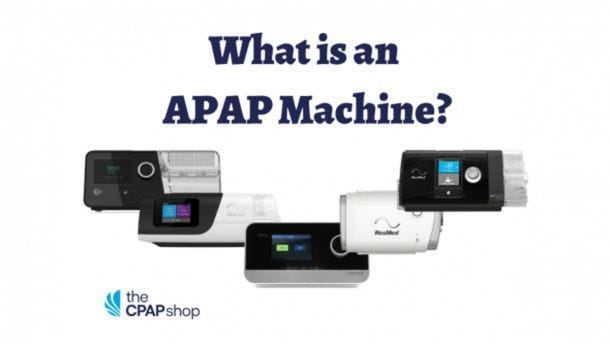What is an APAP Machine?
Automatic positive airway pressure, APAP, is one of the three main forms of positive airway pressure or PAP therapy. APAP automatically adjusts to meet each specific person’s breathing needs, which often change throughout the night as we move in and out of different stages of sleep.
By constantly measuring how much resistance is present in your breathing on a breath-by-breath level, APAP technology knows whether to decrease pressure when your upper airway is stable and increase pressure when it senses an airway event.
What is An APAP Machine Used For?
APAP machines are often a treatment alternative for sleep apnea patients over CPAP machines. Unlike a CPAP machine, APAP machines only deliver the amount of pressure that’s necessary at any given moment during therapy. Physicians sometimes find that patients with more complex sleep apnea conditions (such as REM-related apnea or positional apnea), or patients who simply cannot get used to standard CPAP therapy, may experience better results with APAP therapy.
What Does an APAP Machine Look Like?
Most APAP machines look very similar to CPAP machines. Patients will wear a mask that has a tube connected to the machine much like a CPAP machine. The only difference between CPAP machines and APAP machines is how the technology affects the breathing pattern of the patient. CPAP machines only provide a direct and continuous airflow, while an APAP machine varies the airflow based on changes in the patient’s breathing.
How Does an APAP Machine Work?
The majority of machines employ a set pressure that’s determined during a titration study in the sleep center. The APAP machine has two separate settings. One is low pressure; the other is high. These different pressures allow the machine to automatically adjust to your patient’s varying pressure needs throughout the night as they change sleeping positions or go through their various sleep stages.
The APAP machine increases automatically as needed to allow normal breathing during sleep. When the patient has an obstructive apnea, this type of device increases pressure just enough to return breathing to normal. The air pressure from the machine rises and falls throughout the night as needed to keep the airway open.
Benefits Of an APAP Machine
Two operating modes: APAP machines offer continuous mode (CPAP) or auto adjusting mode. This allows patients to try out both CPAP and APAP without changing devices.
Adapts pressure with different sleeping positions: Because the pressure can change throughout the night, patients can change sleeping positions and receive the amount of pressure they need.
Increased comfort: Patients typically require less pressure in lighter sleep stages, but APAP machines only deliver higher pressure when apnea events are occurring.
Drawbacks Of an APAP Machine
Cost: APAP machines are sophisticated devices. Because of this, they tend to be more costly than CPAP machines, and some insurance plans do not provide coverage for them.
Adjustments can be slow: When the machine adapts, sometimes it can be a little slow to make adjustments, and this can cause disturbances in sleep.
Patients with certain health conditions should not use APAP: People with chronic heart failure or obesity hypoventilation syndrome are not appropriate candidates for this therapy.
How To Use an APAP Machine
APAP comes with a mask that you wear over your mouth. It's connected to a small device that gently pushes air into your throat. If your sleep apnea is uncomplicated, you might be able to start using your APAP right away after your doctor diagnoses you, without visiting a sleep center first.
After your training, make sure you’re confident that you know how to use your APAP. Your checklist may include:
- Check that the mask fits properly before you start.
- Let your doctor know if the mask doesn’t stay on or leaks air.
- Give yourself time to get used to the machine and the varying air pressure.
- Ask your doctor if it’s a good idea to track your symptoms to see how much APAP helps.
How To Clean an APAP Machine
Follow these simple steps for cleaning:
1. Unplug your APAP machine from the power source.
2. Disconnect the mask and air tubing from the APAP machine.
3. Disassemble your mask into 3 parts (headgear, cushion and frame).
4. In a sink or tub, clean your mask cushion and headgear to remove any oils. Gently rub with soap and warm, drinking-quality water.
5. Rinse again thoroughly with warm, drinking-quality water.
6. Place the cushion and frame on a flat surface, on top of a towel, to dry. Avoid placing them in direct sunlight.
How Much Does an APAP Machine Cost?
APAP machines can be more costly than CPAP machines. The extra cost is worth it for those with sleep apnea who have difficulty adapting to CPAP therapy. APAP machines can range in price from $335-$1,198.
Many of the lower cost APAP machines may have fewer features than the more expensive machines. Select an APAP machine based on your budget and your therapy needs. Speak to your doctor about selecting an APAP machine that fits you.
CPAP vs APAP
There are many different sleep apnea treatments on the market today. The most popular are APAP and CPAP machines. Choosing the correct treatment is crucial to managing your patient’s condition.
There are several differences between APAP and CPAP machines, but the main one is that CPAP machines offer one steady airway pressure (that must be set by a doctor or sleep specialist) and APAP machines have airway pressure that can adjust automatically based on your needs.
Let’s take a look at the differences between APAP and CPAP:
Multiple breathing changes. In general, patients who experience multiple changes in their breathing throughout the night tend to opt for APAP machines to manage and treat their sleep disordered breathing.
Tossing and turning throughout the night. APAP machines are oftentimes better suited for patients who tend to toss and turn throughout the night. Because of gravity, patients in REM sleep or supine sleepers have the most respiratory events as opposed to people who sleep prone or laterally.
REM sleep. REM sleep is a deep stage of sleep that restores cognitive functioning and memory. Throughout this stage, breathing is irregular, temperature isn’t regulated, and blood pressure can often spike. These changes are true for everyone, whether or not they have sleep apnea. For people who have REM related sleep apnea, the APAP device is ideal as it only increases pressure to compensate during this sleep stage. Learn more about comparing CPAP vs APAP.
APAP vs BiPAP
Some patients may want to consider APAP vs. BiPAP therapy. Many patients may have to explore different options before they find the one that best suits their needs for therapy. Here are some of the differences between APAP and BiPAP:
More flexible breathing patterns. APAP adapts to multiple variations in your breathing while BiPAP is limited to only two distinct pressure settings. If variations in exhalation and inhalation are enough to stay compliant, then BiPAP therapy may ne adequate compared to the cost of APAP.
An alternative when BiPAP does not work. If you have tried BiPAP without success, APAP can be a more effective alternative for your therapy. One therapy is not better than another. Every patient is different.
Weight changes. BiPAP machines don’t allow for physical changes in patients, such as weight loss, for example. It’s generally recommended that after a patient increases or decreases their body weight by ten percent, a BiPAP patient should undergo an evaluation to see whether they need an increase or decrease in pressure.
The limited pressure settings might eventually be too weak or too strong for the patient's needs. With an APAP machine, pressures adjust automatically to compensate for any weight loss or gain that may occur over a protracted time period.
What Is the Best APAP Machine?
APAP machines can vary by cost based on what extra features are included, so it is important to choose one that has the features you need at a cost you can afford. Here are few points to consider when comparing machines:
Travel vs home machines. Some machines are designed to be compact and lightweight for travel. Decide if you may need a home APAP machine or one for on the go.
Comfort features. Some APAP machines feature comfort-enhancing features such as heated humidifiers. If you have side effects from your therapy such as a sore nose or throat due to dry air, then you may want an APAP machine with these added benefits.
Do You Need a Prescription for An APAP Machine?
All CPAP therapy, whether you decided on CPAP, APAP or BiPAP requires a prescription from your doctor. You can discuss with your doctor if an APAP is a better choice for your specific therapy. Often you may have to try different types of therapy to determine which one works best for you.
If you have difficulty with CPAP therapy, your doctor may recommend an APAP as an alternative. The prescription however has less to do with the machine you choose and more to do with the proper pressure settings you will need for your therapy.
Where Can I Buy an APAP Machine for Sleep Apnea Treatment?
You can find a variety of APAP machine brands for your sleep apnea treatment at The CPAP Shop. We can help you choose a machine that best fits your personal comfort needs and your prescription. You may also receive free shipping on some APAP machines based on cost. Give us a call at 866-414-9700 today!




